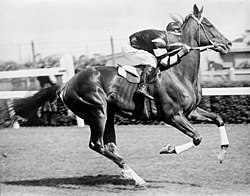Phar Lap
| Phar Lap | |
|---|---|

Phar Lap with jockey Jim Pike at Flemington Racecourse c. 1930.
|
|
| Sire | Night Raid (GB) |
| Grandsire | Radium (GB) |
| Dam | Entreaty (NZ) |
| Damsire | Winkie (GB) |
| Sex | Gelding |
| Foaled | 4 October 1926 |
| Country | New Zealand |
| Colour | Chestnut |
| Breeder | Alick Roberts |
| Owner | David Davis and Harry Telford |
| Trainer | Harry Telford |
| Record | 51:37–3–2 |
| Earnings | £A66,738 |
| Major wins | |
|
AJC Derby (1929) Victoria Derby (1929) Linlithgow Stakes (1930) Futurity Stakes (1930) Melbourne Cup (1930) Chipping Norton Stakes (1930) Cox Plate (1930 & 1931) Melbourne Stakes (1930 & 1931) Underwood Stakes (1931) Agua Caliente Handicap (1932) |
|
| Honours | |
|
#22 – Top 100 U.S. Racehorses of the 20th Century 1983 Motion Picture – Phar Lap: Heart of a Nation Australian Racing Hall of Fame New Zealand Racing Hall of Fame |
|
| Last updated on 29 April 2009 | |
Phar Lap (4 October 1926 – 5 April 1932) was a champion Thoroughbred racehorse whose achievements captured the public's imagination during the early years of the Great Depression. Foaled in New Zealand, he was trained and raced in Australia by Harry Telford. Phar Lap dominated Australian racing during a distinguished career, winning a Melbourne Cup, two Cox Plates, an AJC Derby, and 19 other weight for age races. He then won the Agua Caliente Handicap in Tijuana, Mexico, in track-record time in his final race. After a sudden and mysterious illness, Phar Lap died in 1932. At the time, he was the third highest stakes-winner in the world.
His mounted hide is displayed at the Melbourne Museum, his skeleton at Museum of New Zealand Te Papa Tongarewa and his heart is currently on display at the National Museum of Australia, Canberra.
The name Phar Lap derives from the common Zhuang and Thai word for lightning: ฟ้าแลบ [fáː lɛ̂p], lit. 'sky flash'.
Phar Lap was called the "Wonder Horse", "Red Terror", "Bobby" and "Big Red" (the latter nickname was also given to two of the greatest United States racehorses, Man o' War and Secretariat). He was sometimes referred to as "Australia's wonder horse".
According to the Museum of Victoria, Aubrey Ping, a medical student at the University of Sydney, suggested "farlap" as the horse's name. Ping knew the word from his father, a Zhuang-speaking Chinese immigrant. Telford liked the name, but changed the F to PH to create a seven letter word, which was split in two in keeping with the dominant naming pattern of Melbourne Cup winners.
...
Wikipedia
